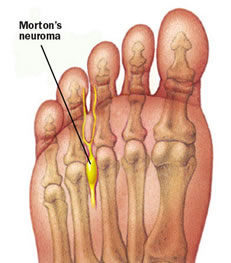in Foot and Ankle Surgery and Reconstruction
This is a condition first described by Thomas Morton in 1876 where he related pain in the front of the foot with a suspected swelling on the nerve travelling to the toes. The very small lump on the nerve is usually found just between the toes. The “lump” is not usually visible or noticed under the skin. The toes or front of the foot can then get painful or numbness can be felt. The word neuroma implies a swelling or lump on the nerve.
Probably caused by the nerve getting repeatedly squashed or trapped between the ends of the metatarsal bones in the foot and gradually the nerve enlarges. It is much common in women, possibly related to the popularity of narrow, high-heeled shoes worn by female patients. Occasionally direct trauma to the area can cause swelling and pressure on the nerve. It is not always clear why people do get a Mortons Neuroma.
 Commonly involves pain on the sole of the foot between the ends of the metatarsal bones (balls of feet) that becomes worse on walking/running. The pain can be burning, stabbing or the toes can feel numb or tingling. Occasional “catching” pain in this area can result in sharp pains, This is probably the nerve getting trapped between the bones. Sometimes the pain moves further along the foot or up the leg. Wearing flip-flops or going bare foot can often relieve the pain.
Commonly involves pain on the sole of the foot between the ends of the metatarsal bones (balls of feet) that becomes worse on walking/running. The pain can be burning, stabbing or the toes can feel numb or tingling. Occasional “catching” pain in this area can result in sharp pains, This is probably the nerve getting trapped between the bones. Sometimes the pain moves further along the foot or up the leg. Wearing flip-flops or going bare foot can often relieve the pain.
The clinical features as discussed above along with an accurate examination by the surgeon can usually make the diagnosis, but sometimes it can be difficult. In addition to clinical examination, using an ultrasound done by a radiologist can visualise the neuroma to aide diagnosis.
People often “live” with the symptoms for many years and then finally seek medical attention. If you decide not to see your doctor, the problem will tend to progress, usually slowly, with no significant consequence.
The treatment can be operative or non-operative.
Initial treatment may involve wider, softer and more shock absorbing shoes with a lower heel to reduce the compression around the neuroma. Insoles can be moulded to alleviate symptoms, but often are not hugely successful. Next, the neuroma can be injected with cortisone and anaesthetic (using ultrasound), which can be curative in around 30-40% of patients. If symptoms still persist, then surgical excision of the neuroma can be performed.
Many patients are simply seeking advice on managing a problem. In some cases modifying shoes or injections can prove a successful therapy however if not, then surgery can be indicated and the timing of the surgery can be arranged to suit your needs.